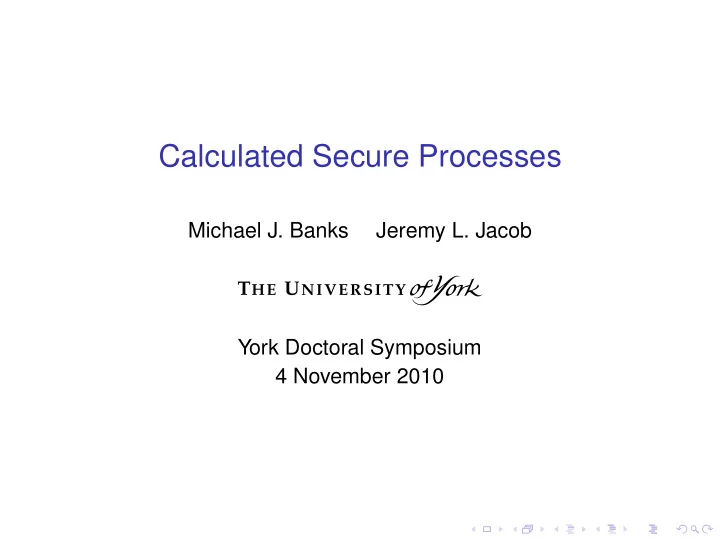

Calculated Secure Processes Michael J. Banks Jeremy L. Jacob York Doctoral Symposium 4 November 2010
What’s this talk about? Formal methods are used in software development when the behavioural correctness of systems is paramount. Specification What properties should a system possess? Verification Does a system satisfy its specification? How can we use formal methods to construct secure software? ◮ Confidential (sensitive or valuable) information must be protected from being disclosed to untrusted users ◮ We aim to guarantee information flow security
Communicating Sequential Processes (CSP) Background CSP is a well-known process algebra for specifying systems: ◮ originally due to Hoare; revised by Hoare, Brooks, Roscoe ◮ a process interacts with environment by performing events ◮ process semantics given by a model (traces, failures, . . . ) CSP Notation a → S engage in event ‘ a ’, then behave as process S S ⊓ T non-deterministic choice between S and T S ✷ T deterministic choice between S and T S ; T behave as S until it terminates, then behave as T
Users, Observations and Information Flow A motivational example Consider the process specification: M � ( h → l → M ) ⊓ ( k → Stop ) Suppose that: ◮ user Low can observe ‘ l ’ events only; ◮ Low has complete knowledge of M ’s structure; and ◮ Low must be unable to establish if ‘ h ’ occurs Question: is M secure?
Users, Observations and Information Flow A motivational example Consider the process specification: M � ( h → l → M ) ⊓ ( k → Stop ) Question: is M secure? If Low observes � l � , it can calculate that M ’s trace must be in: {� h , l � , � h , l , h � , � h , l , k �} and so Low can infer that (at least one) ‘ h ’ must have occurred!
The < P , Q > operator We limit the flow of information to Low by inserting alternative “cover story” behaviours consistent with Low’s observations. ◮ Cover stories represent non-confidential behaviours ◮ Idea: If Low cannot rule out all cover stories, it cannot establish that any confidential activity has taken place We write < P , Q > , where: ◮ P is a process specifying confidential behaviours ◮ Q is a process specifying cover story behaviours ◮ and Low must be unable to distinguish P from Q
Applying < P , Q > to Processes The semantics of < P , Q > ( S ) are defined by algebraic laws. Law 3 (carry prefix; confidential not applicable) provided P cannot perform an ‘ a ’ event: < P , Q > ( a → S ) � a → < P , Q > ( S ) Law 4 (extension by cover story) provided S can behave as X : < a → X , b → Y > ( a → S ) � � � a → < a → X , b → Y > ( S ) b → Y ; < a → X , b → Y > ( S “after” X ) ✷
Securing M Continuing the example Low cannot deduce the occurrence of ‘ h ’ immediately before ‘ l ’: P � h → l → Skip Q � l → Skip Applying the algebraic laws, we calculate M ′ = < P , Q > ( M ) : M ′ = < P , Q > (( h → l → M ) ⊓ ( k → Stop )) h → l → M ′ ✷ l → M ′ � ⊓ k → Stop � = Is M ′ secure? If Low observes � l � , the trace of M ′ must be a member of: {� h , l � , � h , l , h � , � h , l , k � , � l � , � l , k �} and Low can no longer infer that ‘ h ’ has occurred.
Verifying Security with respect to < P , Q > Applying < P , Q > to a process S yields a secure process with respect to the confidentiality property encoded by P , Q . Theorem Given any Low-observation of < P , Q > ( S ) , Low can never establish (with certainty) that a P activity has taken place. Definition S is secure (with respect to P , Q ) provided < P , Q > ( S ) = S But adding cover stories may violate functional requirements.
Related Work Classical notion of information flow security is noninterference: ◮ Low can learn nothing about high-level user’s activities ◮ Often too strong for practical software development! ◮ Our notion of confidentiality is weaker than noninterference We have not considered factors outside the model: ◮ probability of confidential behaviours, relative to cover stories ◮ timing of events ◮ power consumption (We need a richer CSP semantic model to reason about these.)
Conclusion Contribution ◮ An operator for rewriting CSP processes to ensure they satisfy confidentiality properties ◮ Encoding confidentiality properties via processes is original Future work ◮ How can application of the operator be automated? ◮ Refinement reduces non-determinism within processes, but doing so may introduce new sources of information flow!
Finally. . . Thanks for listening! Slides and paper are available at: http://www-users.cs.york.ac.uk/~mbanks/
Recommend
More recommend